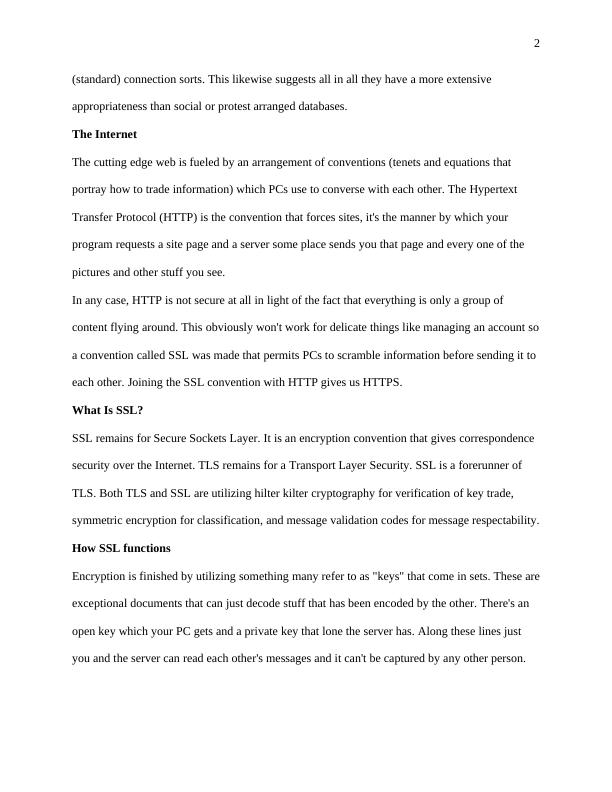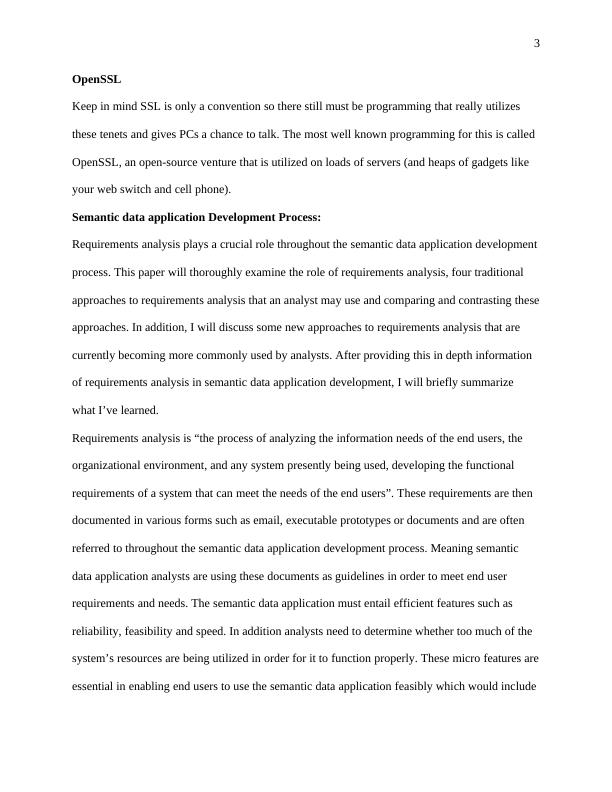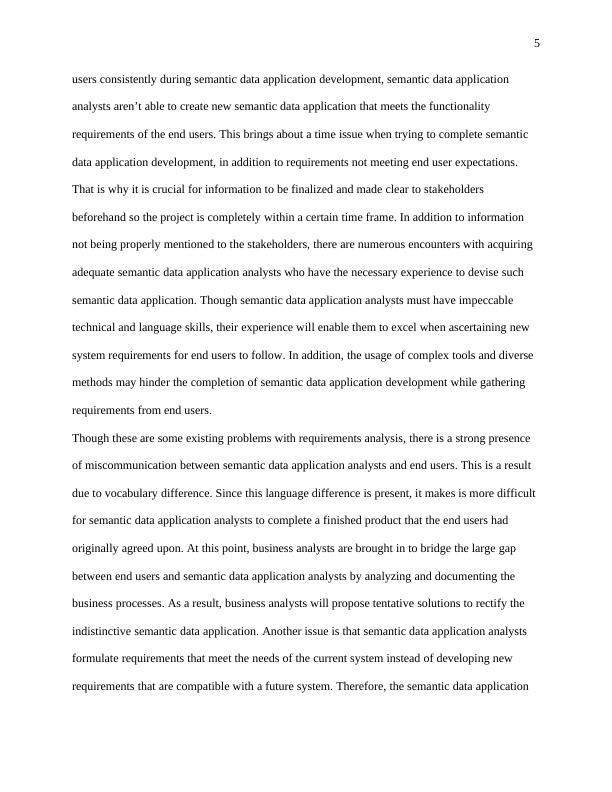Semantic Information Demonstrates PDF
Added on 2019-12-28
22 Pages7036 Words384 Views
1Introduction:Semantic information demonstrates in programming designing has different implications: It is a reasonable information display in which semantic data is incorporated. This implies the model depicts the importance of its occurrences. Such a semantic information model is a deliberation that characterizes how the put away images (the occurrence information) identify with the genuine world.It is a theoretical information demonstrate that incorporates the capacity to express data that empowers gatherings to the data trade to decipher meaning (semantics) from the cases, without the need to know the meta-show. Such semantic models are reality situated (instead of question arranged). Realities are ordinarily communicated by paired relations between information components, though higher request relations are communicated as accumulations of twofold relations. Regularly parallel relations have the type of triples: Object-Relation Type-Object. For instance: the Eiffel Tower <is found in> Paris. Regularly the occasion information of semantic information models expressly incorporate the sorts of connections between the different information components, for example, <is found in>. To translate the significance of the truths from the cases it is required that the importance of the sorts of relations (connection sorts) be known. Thusly, semantic information models normally institutionalize such connection sorts. This implies the second sort of semantic information models empower that the examples express truths that incorporate their own particular significance. The second sort of semantic information models are typically intended to make semantic databases. The capacity to incorporate importance in semantic databases encourages building disseminated databases that empower applications to translate the significance from the substance. This suggests semantic databases can be incorporated when they utilize the same

2(standard) connection sorts. This likewise suggests all in all they have a more extensive appropriateness than social or protest arranged databases. The Internet The cutting edge web is fueled by an arrangement of conventions (tenets and equations that portray how to trade information) which PCs use to converse with each other. The Hypertext Transfer Protocol (HTTP) is the convention that forces sites, it's the manner by which your program requests a site page and a server some place sends you that page and every one of the pictures and other stuff you see. In any case, HTTP is not secure at all in light of the fact that everything is only a group of content flying around. This obviously won't work for delicate things like managing an account soa convention called SSL was made that permits PCs to scramble information before sending it to each other. Joining the SSL convention with HTTP gives us HTTPS. What Is SSL? SSL remains for Secure Sockets Layer. It is an encryption convention that gives correspondence security over the Internet. TLS remains for a Transport Layer Security. SSL is a forerunner of TLS. Both TLS and SSL are utilizing hilter kilter cryptography for verification of key trade, symmetric encryption for classification, and message validation codes for message respectability.How SSL functions Encryption is finished by utilizing something many refer to as "keys" that come in sets. These areexceptional documents that can just decode stuff that has been encoded by the other. There's an open key which your PC gets and a private key that lone the server has. Along these lines just you and the server can read each other's messages and it can't be captured by any other person.

3OpenSSL Keep in mind SSL is only a convention so there still must be programming that really utilizes these tenets and gives PCs a chance to talk. The most well known programming for this is called OpenSSL, an open-source venture that is utilized on loads of servers (and heaps of gadgets like your web switch and cell phone).Semantic data application Development Process:Requirements analysis plays a crucial role throughout the semantic data application developmentprocess. This paper will thoroughly examine the role of requirements analysis, four traditional approaches to requirements analysis that an analyst may use and comparing and contrasting theseapproaches. In addition, I will discuss some new approaches to requirements analysis that are currently becoming more commonly used by analysts. After providing this in depth information of requirements analysis in semantic data application development, I will briefly summarize what I’ve learned.Requirements analysis is “the process of analyzing the information needs of the end users, the organizational environment, and any system presently being used, developing the functional requirements of a system that can meet the needs of the end users”. These requirements are then documented in various forms such as email, executable prototypes or documents and are often referred to throughout the semantic data application development process. Meaning semantic data application analysts are using these documents as guidelines in order to meet end user requirements and needs. The semantic data application must entail efficient features such as reliability, feasibility and speed. In addition analysts need to determine whether too much of the system’s resources are being utilized in order for it to function properly. These micro features areessential in enabling end users to use the semantic data application feasibly which would include

4the semantic data application performing an assigned task. Though meeting the end users needs is vital in developing sufficient semantic data application that is compatible with a system, there have been many problems using requirements analysis.Though requirements analysis is a process that facilitates semantic data application analysts designing sufficient semantic data application for end users, there have been numerous problems creating semantic data application that is compatible with future systems. According to Tom DeMarco, he states in his journal “numerous studies have shown that over half of the semantic data application development projects don’t work.” In other words, when end users are using the semantic data application, it is not meeting their functionality expectations. This is due to information not being properly clarified. This is referred to as the requirements elicitation process, which means there is difficulty obtaining information for requirements out of the end users. When end users are asked about the kind of processes they would like the semantic data application to perform, they are able to identify their wants but not their needs. Though semantic data application analysts are verbally asking direct questions to the end users and are written down as a guideline for analysts to follow, these requests made by the users are not being automated. Therefore, when semantic data application analysts are developing semantic data application for future systems, it will never meet the users needs due to them not accurately stating what they need. Though analysts may follow the requirements elicitation process competently, the future system will not meet the user’s needs. Another posing problem with requirements analysis is that it is difficult to pinpoint accurate information to the stakeholders. According to Steve McConnell, communication with end users is very slow, they won’t commit to a set of written requirements and they demand new requirements once fixed costs have been finalized. Since new changes are being iterated by end

5users consistently during semantic data application development, semantic data application analysts aren’t able to create new semantic data application that meets the functionality requirements of the end users. This brings about a time issue when trying to complete semantic data application development, in addition to requirements not meeting end user expectations. That is why it is crucial for information to be finalized and made clear to stakeholders beforehand so the project is completely within a certain time frame. In addition to information not being properly mentioned to the stakeholders, there are numerous encounters with acquiring adequate semantic data application analysts who have the necessary experience to devise such semantic data application. Though semantic data application analysts must have impeccable technical and language skills, their experience will enable them to excel when ascertaining new system requirements for end users to follow. In addition, the usage of complex tools and diverse methods may hinder the completion of semantic data application development while gathering requirements from end users.Though these are some existing problems with requirements analysis, there is a strong presence of miscommunication between semantic data application analysts and end users. This is a result due to vocabulary difference. Since this language difference is present, it makes is more difficult for semantic data application analysts to complete a finished product that the end users had originally agreed upon. At this point, business analysts are brought in to bridge the large gap between end users and semantic data application analysts by analyzing and documenting the business processes. As a result, business analysts will propose tentative solutions to rectify the indistinctive semantic data application. Another issue is that semantic data application analysts formulate requirements that meet the needs of the current system instead of developing new requirements that are compatible with a future system. Therefore, the semantic data application

6is not meeting the needs of the end users, which is the main objective. By analysts focusing on mending the current system, it takes away time for them to devise new system requirements for the future system. This is significant problem because end users want to use new semantic data application for a future system, not current semantic data application that has been fixed. In addition, analysis is being carried out by analysts instead of personnel who have great personableskills. Due to this factor, the needs of the end users are being misinterpreted and not properly iterated to the analysts to create semantic data application that is sufficient. This generates more issues that aren’t needed and leads to poor system functionality. There are many approaches to facilitate the process of requirements analysis but the approaches that I will be discussing are use cases, prototyping, agile semantic data application development and interviewing. All of these approaches allow end users to feasibly identify requirements needed to develop sufficient semantic data application. Though each of these approaches may be effective, each approach stands out because of its own prevalent features. In order to comprehendthe various features affiliated with each approach, we will take an in depth look at each approach. The first approach we will look at will be use cases.Use cases are utilized for capturing functional requirements of a system by each case providing one or more scenarios that suggests to the end user how they should interact with the system. Each use case is focused on portraying how to accomplish a goal or objective, which may entail the usage of multiple use cases to accept the scope of the new system. Based upon the degree of formality of a semantic data application project, it will influence the detail level that is incorporated into each use case. This is important because the more extensive the detail, the better the functionality of the semantic data application. Though use cases treat the current system as a black box, this is due to system interactions and responses that must be analyzed in

End of preview
Want to access all the pages? Upload your documents or become a member.
Related Documents
Networking Fundamentals: Overview of Protocols, Standards and Cable Typeslg...
|8
|2229
|137
Overview of Network Securitylg...
|4
|915
|75
Networking and Security - Report on OSI and TCP/IP referencing modellg...
|6
|2003
|370
